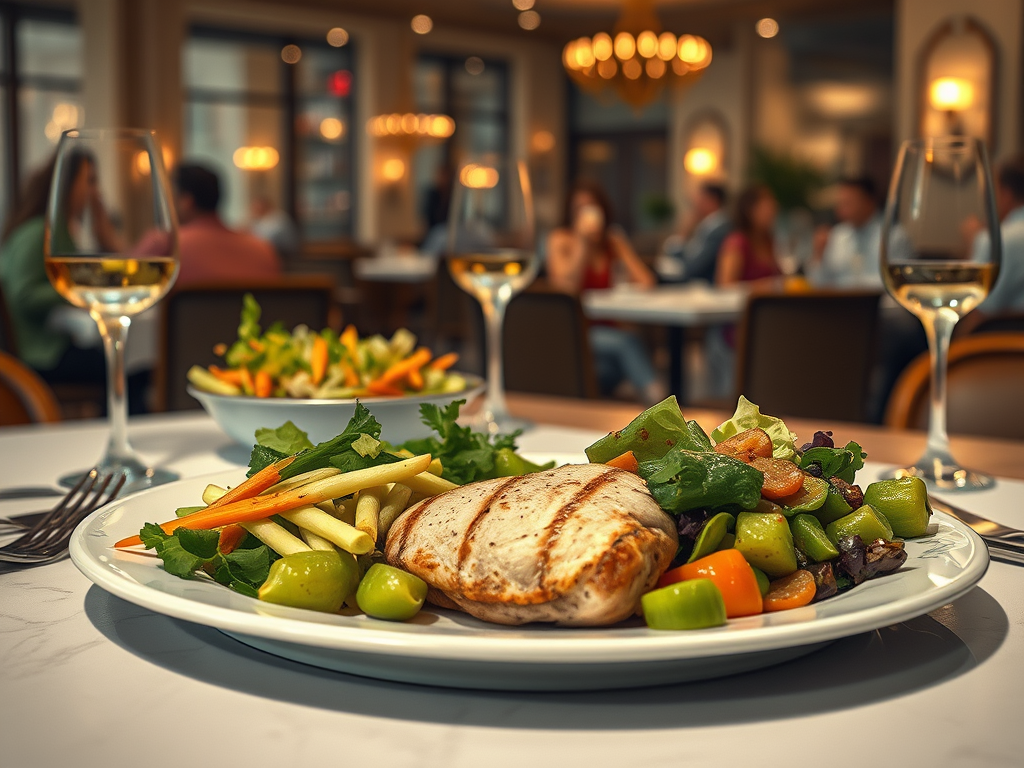Dining out is one of life’s genuine pleasures – a chance to connect with loved ones, explore new cuisines, and take a much-needed break from cooking. For individuals managing diabetes, however, the prospect of a restaurant meal can often be tinged with anxiety. The fear of hidden sugars, oversized portions, and unfamiliar ingredients can feel like a direct threat to carefully managed blood sugar levels and weight goals. But what if we told you that enjoying your favorite restaurants doesn’t have to be a battle between pleasure and health?
The truth is, dining out with diabetes and maintaining weight control isn’t about restriction; it’s about empowerment through informed choices. It’s about transforming a potentially daunting experience into an opportunity to practice mindful eating and celebrate a balanced lifestyle. With a bit of preparation and the right strategies, you can savor delicious meals without derailing your progress.
As the renowned American author and physician Dr. Dean Ornish once wisely stated, “Sometimes the most profound and life-altering actions are just small shifts in what we choose to put in our bodies.” This sentiment perfectly encapsulates the journey of managing diabetes and weight while embracing life’s culinary joys. It’s not about perfect adherence, but about consistent, wise choices that add up over time.
This article will guide you through practical, encouraging strategies to navigate any menu with confidence, ensuring your dining experiences are both delightful and beneficial for your health.
The Mindset Shift: From Fear to Freedom
Before we dive into specific tactics, let’s address the most crucial element: your mindset. Many people with diabetes view dining out as a minefield. Instead, try to see it as an extension of your healthy lifestyle. You’ve already committed to managing your health; this is just another arena in which to apply those principles. Embrace the idea that you are in control, and every choice is an opportunity to nourish your body and mind. This positive outlook is truly foundational.
Pre-Dining Strategies: Your Secret Weapons
Success in dining out often begins long before you even step foot in the restaurant. A little planning can make a significant difference.
- Research is Your Best Friend: In today’s digital age, most restaurants have their menus (and often nutritional information) available online. Take advantage of this!
- Scan for Healthier Options: Look for dishes that are grilled, baked, broiled, or steamed. Select lean proteins and a variety of vegetables.
- Identify Potential Pitfalls: Note items that are likely high in sugar, unhealthy fats, or refined carbohydrates (e.g., creamy sauces, fried foods, large pasta dishes).
- Check for Substitutions: Many menus offer substitutions, or you can mentally note what you might request (e.g., swapping fries for a side salad or steamed vegetables).
- Plan Your Day’s Meals: Don’t starve yourself all day in anticipation of a large meal, as this can lead to overeating and poorer choices. Instead, adjust your other meals. If you anticipate a heavier dinner, opt for lighter, protein- and vegetable-rich meals earlier in the day. This helps balance your overall carbohydrate and calorie intake.
- Hydrate Smartly: Drink a large glass of water before you leave for the restaurant. Sometimes, thirst is mistaken for hunger, leading to unnecessary snacking or overeating. Continuing to drink water throughout your meal can also help you feel fuller faster.
- Consider a Light Pre-Meal Snack: If you know you’ll be waiting a while or are prone to extreme hunger, a small, protein-rich snack (like a handful of almonds, a hard-boiled egg, or a few slices of cheese) an hour or so before dining can curb intense hunger and prevent impulsive, less healthy choices.
During-Dining Tactics: Navigating the Menu Like a Pro
Once you’re at the restaurant, it’s time to put your strategies into action with confidence and kindness towards yourself.
- Skip the Bread Basket (or Be Mindful): The complimentary bread basket, while tempting, can quickly add unnecessary carbohydrates and calories. Politely ask the server to remove it, or if others at your table want it, exercise willpower and focus on your main meal. If you must have a piece, opt for whole grain varieties and limit yourself to one small slice.
- Appetizers: Choose Wisely: Many appetizers are deep-fried or loaded with cheese. Look for healthier options like:
- Broth-based soups: Clear soups are generally a better choice than creamy ones.
- Salads: Order dressing on the side and use it sparingly. Load up on fresh veggies, and choose lean protein toppings.
- Shrimp cocktail or grilled calamari: These can be good protein-rich options if not fried or swimming in butter.
- The Main Course – Building Your Plate: This is where the bulk of your meal comes from, so make it count!
- Prioritize Lean Protein: Choose grilled, baked, broiled, or roasted options like fish, chicken breast (skinless), turkey, lean cuts of beef (sirloin, filet mignon), or plant-based proteins like tofu or legumes. These provide satiety without excessive calories or unhealthy fats, supporting both blood sugar stability and weight management.
- Double Up on Non-Starchy Vegetables: This is your secret weapon for fullness and nutrient intake. Ask for extra steamed, grilled, or roasted non-starchy vegetables (such as broccoli, spinach, asparagus, green beans, or bell peppers) instead of fries, mashed potatoes, or rice. Don’t be shy about asking if vegetables can be prepared without butter or heavy sauces.
- Be Mindful of Carbohydrates: If you choose a starchy side (such as rice, pasta, or potatoes), be mindful of portion sizes. Aim for a portion roughly the size of a cupped hand. Opt for brown rice or whole-wheat pasta if available.
- Sauces and Dressings: On the Side: Sauces and dressings are often hidden sources of sugar, unhealthy fats, and calories. Always ask for them on the side so you can control the amount you use. A little goes a long way.
- Cooking Methods Matter: Steer clear of “fried,” “crispy,” “creamy,” “breaded,” or “battered” descriptions. Favor “grilled,” “broiled,” “baked,” “steamed,” or “roasted.”
- Portion Control: A Visual Aid: Restaurant portions are notoriously oversized.
- The “To-Go Box” Tactic: As soon as your meal arrives, ask for a to-go box. Immediately put half of your meal into the box. This helps you manage your intake and provides a delicious, pre-portioned meal for later.
- Share an Entree: If you’re dining with a companion, consider splitting an entree. Many restaurants serve portions large enough for two.
- Beverages: Beyond Water: While water is always the best choice, if you opt for something else:
- Unsweetened Options: Opt for unsweetened tea, coffee, or sparkling water with a lemon or lime wedge.
- Avoid Sugary Drinks: Steer clear of regular sodas, sweet iced teas, fruit punches, and many mixed cocktails, which are loaded with sugar and empty calories.
- Alcohol Moderation: If you choose to drink alcohol, do so in moderation (one drink for women, two for men) and opt for lighter choices like a dry wine or light beer, consumed with food to prevent blood sugar drops.
- Dessert: A Thoughtful Indulgence: Desserts are often sugar and calorie bombs.
- Share, Share, Share: If you truly want a taste, share one dessert among the table.
- Fruit-Based Options: Look for fresh fruit, berries, or a small fruit sorbet.
- Coffee/Tea: Sometimes, a warm cup of decaffeinated coffee or herbal tea can be a satisfying end to the meal.
Communication is Your Ally
Don’t be afraid to speak up politely. Servers are accustomed to special requests. Phrases like “Could I please get the dressing on the side?” or “Is it possible to substitute the fries for steamed vegetables?” or “Could you please hold the butter on the vegetables?” are perfectly acceptable and common. Remember, your health is your priority, and a good restaurant wants you to have an enjoyable experience.
Post-Dining Reflection: Progress, Not Perfection
So, you’ve dined out, made your best choices, and enjoyed the experience. What’s next?
- Don’t Beat Yourself Up: If you had a moment of indulgence or didn’t make every single “perfect” choice, it’s okay! One meal does not define your entire health journey.
- Adjust and Move On: If you had a larger-than-planned meal, adjust your subsequent meals and perhaps incorporate a bit more physical activity the next day. The key is consistency over perfection.
- Focus on the Positives: Celebrate the healthy choices you did make and the joy you experienced in connecting with others.
Conclusion
Dining out with diabetes and for weight control is not just possible; it can be an enriching part of your healthy lifestyle. By adopting a proactive mindset, leveraging pre-dining strategies, making informed choices at the table, and communicating your needs, you empower yourself to enjoy food and social interactions without compromising your health goals.
Remember, every meal is an opportunity to nourish your body and make choices that support your well-being. Embrace these strategies with confidence and step out to enjoy your next restaurant meal, knowing you have the tools to make it both delicious and diabetes-friendly. You’ve got this!
Discover more from Healthinfo24.com
Subscribe to get the latest posts sent to your email.




Lana521
https://shorturl.fm/2TjsE